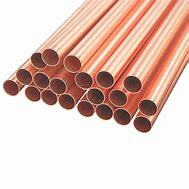1. Introduction
Just 24 hours ago, the London Metal Exchange reported a 3.2% spike in copper prices—the sharpest single-day rise in over six weeks—driven by renewed infrastructure spending in North America and supply concerns from major mines in Chile. This surge directly impacts everything from copper rod price to copper strip price and even ac copper pipe price, making it more critical than ever to understand which copper products deliver the best value for your specific needs.

Whether you’re grounding an electrical system, welding copper components, or sourcing materials for HVAC installations, not all copper rods are created equal. In this deep dive, we’ll compare and contrast key types—including copper earth rod, copper brazing rod, and copper welding rod—and explore how alternatives like copper bonded steel or copper clad ground rod stack up in performance, cost, and longevity.
2. Understanding Copper Rod Variants
2.1. Earthing and Grounding Rods: Pure Copper vs. Bonded vs. Clad
When it comes to safety and electrical grounding, the choice between a solid copper earth rod and a copper bonded earthing rod can affect both performance and budget. Solid rod copper (often called round bar copper) offers superior conductivity and corrosion resistance but comes at a premium price. In contrast, copper bonded ground rods consist of a steel core electroplated with a thick layer of copper—typically 10 mils or more—providing a cost-effective middle ground.
Copper clad steel ground rods take a different approach: a steel core is metallurgically bonded with a thinner copper layer (usually 5–10% by volume). While cheaper, they may degrade faster in highly corrosive soils. For most residential and light commercial applications, copper bonded steel offers the best balance of durability and earthing rod price.

2.2. Brazing and Welding Rods: Matching Material to Method
For joining copper components, the right filler matters. Copper brazing rod and copper to copper brazing rods are designed for high-temperature brazing (above 450°C), creating strong, leak-proof joints ideal for plumbing or HVAC systems. These rods often contain phosphorus or silver to improve flow and reduce oxidation.
On the other hand, copper welding rod—or more accurately, copper rod for welding—is used in specialized processes like TIG welding of copper alloys. True copper to copper welding rod is rare; most ‘welding rods’ for copper are actually brazing alloys. Mislabeling is common, so always check the spec sheet. Welding rod copper designed for pure copper requires preheating and inert gas shielding to prevent porosity.
3. Copper Strips and Bars: Beyond the Rod
3.1. Flat and Flexible Conductors

While rod copper dominates grounding and joining applications, flat conductors like copper strip play a vital role in busbars, grounding grids, and RF shielding. Products such as copper earth strip 25x3mm are standard in substation earthing, and prices fluctuate with LME trends. Thin copper strips (e.g., 1mm copper strip) and beryllium copper strip offer high strength and conductivity for electronics.
Flexible copper bus bar and nickel plated copper strip enhance performance in dynamic or corrosive environments. When sourcing, terms like ‘copper strip near me’ or ‘roll of copper strip’ often yield local suppliers—but verify alloy composition to avoid substandard copper alloy strip.
3.2. Stripping and Recycling Considerations
For recyclers, stripping copper wire remains a hot topic. The best way to strip copper wire depends on volume: manual strippers for small batches, automated machines for bulk. Burning copper wire for scrap is illegal in many regions and damages the metal. Instead, focus on fast, clean methods like rotary strippers—especially when dealing with stripping wire for recycling or stripping copper cable from HVAC units.
Note: ‘Copper stip’ and ‘copper stripes’ are common misspellings; the correct term is copper strip or copperstrip in industrial contexts.
4. Copper Pipes and Tubing: Sizing, Soldering, and Substitutes
Though not rods, copper pipe tube systems often intersect with rod-based applications—especially in HVAC. Aircon copper pipe (e.g., 15mm copper pipe or 22mm copper tube) must be sized correctly; 3/4 copper tubing is common for main lines, while 1/2 copper pipe serves branch circuits. Copper pipe soldering requires clean surfaces and proper flux to avoid resoldering copper pipe later.
With rising copper tube price, some turn to PEX plumbing pipes—but copper remains unmatched for heat transfer in air conditioning copper pipe systems. Always match fittings: copper pipe connectors must align with pipe type (Type L, M, etc.).
5. Conclusion
From earthing rod copper to copper round bar and copper strip roll, the ‘right’ copper product depends on your application’s electrical, mechanical, and environmental demands. Solid copper offers peak performance but at higher copper rod price; copper bonded and copper clad steel provide smart compromises. Meanwhile, proper handling—whether stripping copper wire for scrap or selecting the correct copper to copper welding rod—ensures efficiency and compliance. As copper markets remain volatile, informed choices today save cost and headaches tomorrow.
Our Website founded on October 17, 2012, is a high-tech enterprise committed to the research and development, production, processing, sales and technical services of ceramic relative materials such as Choose. Our products includes but not limited to Boron Carbide Ceramic Products, Boron Nitride Ceramic Products, Silicon Carbide Ceramic Products, Silicon Nitride Ceramic Products, Zirconium Dioxide Ceramic Products, etc. If you are interested, please feel free to contact us.

